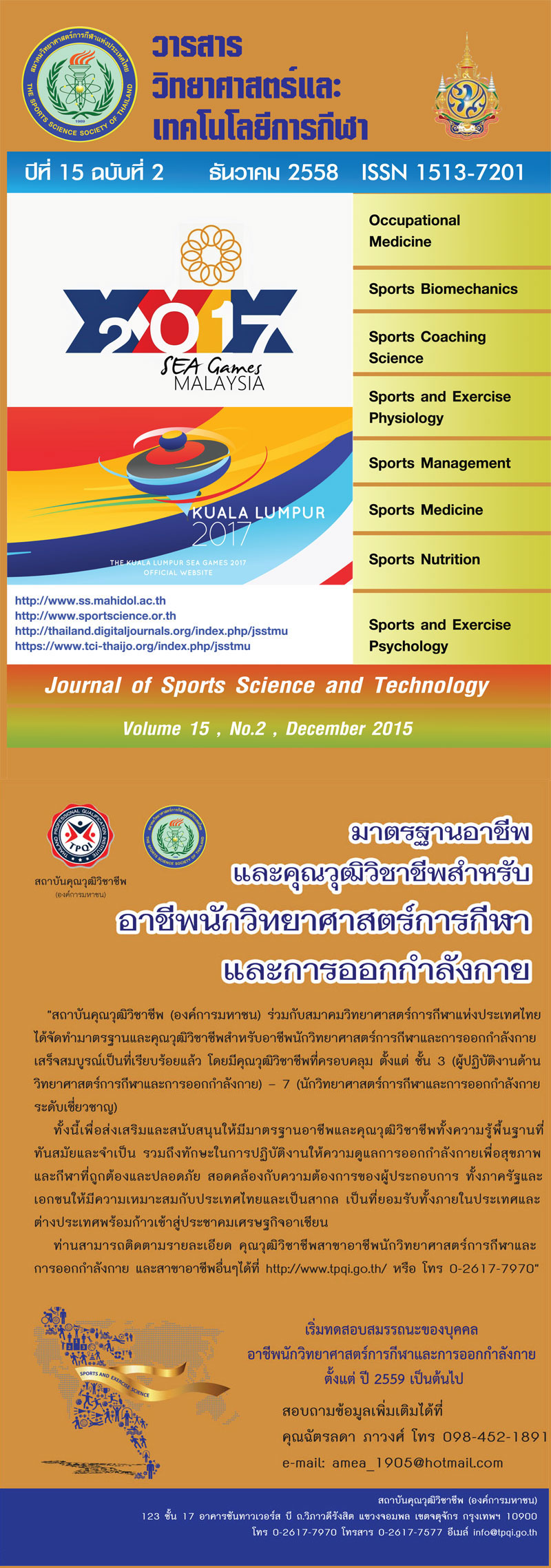DEVELOPMENT OF AN INSTRUMENT TO ASSESS THE MOTIVATIONAL QUALITIES OF MUSIC IN EXERCISE: THAI MUSIC RATING INVENTORY
Keywords:
Inventory development, exercise, motivational music, Thai peopleAbstract
Past research into psychophysical effects of music on physical activity has been characterized bymethodological limitations, such as haphazard selection of music. The purpose of this study was to develop
the Thai Music Rating Inventory (TMRI) and to test aspects of its validity and reliability. The 7-item TMRI was
developed based on literature review, the Brunel Music Rating Inventory-3, and qualitative data from exercise
participants who listened to the music. Back translation was employed to ensure accuracy of the Thai format.
The Content Validity Index of the TMRI was 0.875, which was inspected by experts in related disciplines. To
check subjects’ understanding of the Thai content, the TMRI was first tested on 30 exercise participants as
they listened to the music. The internal consistency of the TMRI was found to be highly reliable: Cronbach’s
Alpha Coefficient for Content was 0.9127. One hundred forty-four participants were selected by Purposive
Sampling, consisting of university students and other exercisers who listened to their preferred music while
exercising. The subjects (39 male, 105 female, ages 15-34,X=21.48, SD=2.97) were asked to respond to the
TMRI. Construct validity was determined through exploratory and confirmatory factor analyses. Exploratory
factor analysis of the TMRI was done, a single factor (motivation) extracted out of seven items. Confirmatory
factor analysis revealed that the TMRI was a good fit (
2= 14.350, df = 11, P-value = 0.214, GFI = 0.973, CFI
= 0.995, RMSEA = 0.0414). The TMRI appears to be a valid and reliable tool for both exercisers and athletes
to assess motivational qualities of music in a fitness or training session. Furthermore, the TMRI enables
researchers to standardize music in experimental protocols involving exercise-related tasks.
(Journal of Sports Science and Technology 2015; 15(2); 405-417)
Downloads
Published
2015-12-28
How to Cite
1.
ONNOM E, SAENGPRASAN C, VONGJATURAPAT N. DEVELOPMENT OF AN INSTRUMENT TO ASSESS THE MOTIVATIONAL QUALITIES OF MUSIC IN EXERCISE: THAI MUSIC RATING INVENTORY. J Sports Sci Technol [internet]. 2015 Dec. 28 [cited 2025 Dec. 17];15(2):405-17. available from: https://he01.tci-thaijo.org/index.php/JSST/article/view/44963
Issue
Section
Research Article






